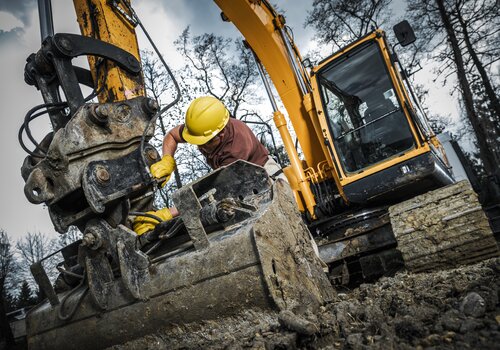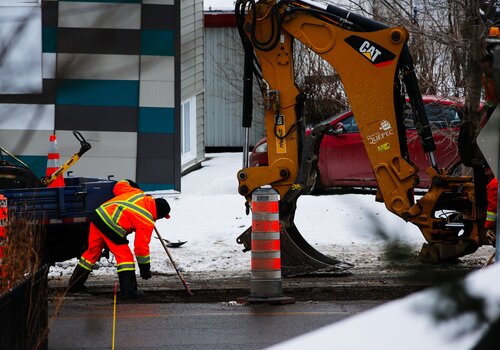Construction equipment theft is everywhere, and if your business hasn’t been a victim yet, it will likely be. Nearly 1,000 pieces of construction equipment are reported stolen each month to the National Crime Information Center (NCIC) but because many thefts go unreported, and there is no one central place tracking all thefts, this number is a low estimate. The National Insurance Crime Bureau estimates the losses total anywhere from $300 million to $1 billion annually.
These losses are only for the machinery itself. As a contractor, stolen construction equipment is also likely to result in downtime on the job, project delays, higher insurance premiums, and a costly deductible. Your insurance coverage could be dropped altogether. Instead of hoping your business won’t be a victim, a better approach is to be proactive about preventing construction equipment theft.
While experts agree there is no 100% foolproof way to prevent theft, there are several actions you can take. “We recommend a layered approach that employs multiple theft prevention strategies,” says Ryan Shepherd, Director & General Manager of Crime Analytics and Supply Chain Solutions at Verisk. His focus is on reducing theft and fraudulent activity in construction and agriculture with the help of data. Verisk manages the National Equipment Register, a database that records equipment theft and ownership records, and offers analytic tools and assistance to the insurance industry and law enforcement.
1. Get notified immediately when equipment is on the move
GPS tracking or theft recovery devices such as Lojack can make a difference because contractors get an immediate notification when their equipment is moved from a geofenced area. The sooner you know about theft, the better the chance of recovery. Immediately report it to the police, insurance company, and the National Equipment Register.
Shepherd says if thieves suspect a machine has such a device, they may let it sit for a few days in an area such as a parking lot to see if someone comes looking for it.
2. Maintain an inventory of equipment
If a piece of construction equipment is stolen, police will want information about the machine. Keeping an inventory of everything you own or lease on hand will save valuable time and improve your chances of recovery. Include the following information for each piece of equipment
- Type of equipment, manufacturer, and model number
- Serial, VIN, or PIN number – if none is available, stamp or engrave a unique number and logo on the equipment and record it.
- Date of purchase
- Location of storage and use
- Photograph
- Personnel authorized to operate the equipment
3. Register your equipment with the National Equipment Register(NER) database
On most construction equipment, serial numbers and PINs are either nonexistent or non-standardized. The lack of titling requirements makes ownership verification difficult. Registering your equipment with the National Equipment Register will help law enforcement identify equipment after a theft. According to Shepherd, the cost is typically just $3-$4 per year, per machine.
4. Employ methods to disable machines or make them less mobile
There are several ways to deter theft by making the equipment immobile or at the very least, less mobile. For example, remove the fuses and circuit breakers when the equipment is unattended or install devices such as a fuel shut-off system, wheel locks, battery switches, ignition locks, and other hidden deactivation devices.
Placing equipment in a wagon-train circle with more easily transported equipment such as generators in the center will also make the equipment more difficult for thieves to move.
5. Use fencing, lighting, and credentialling to secure the job site
Poor lighting and easy access to a jobsite will make your equipment an easy target for thieves. Lighting, fencing, and security cameras all serve as deterrents. Credentialing employees and subcontractors restricts access to authorized personnel and ensures thieves who look like they belong, can’t just pull up to the jobsite and remove equipment.
6. Make connections with law enforcement and the community
When working in an area, Shepherd recommends contractors reach out to community members through local business networks, homeowner and crime-stopper groups about their operations and who to call if something doesn’t appear right. You can also reach out to law enforcement about extra patrols during off hours or holiday weekends. “It’s simple stuff, but it works.”
7. Make sure employees are on board with your security protocols
An effective security plan is only as good as the employees who implement it. “Once you implement a security protocol you need to follow through,” says Shepherd. “Allow your employees time to do what you are asking them.
8. Be aware of when thieves are most likely to strike
Long holiday weekends are the favorite of heavy equipment thieves. They will come in on Friday night, load their trailer, and have a full three days to sell off the equipment before you discover anything missing. This is the time to move equipment to a more secure location or to take extra security measures.
When weighing the cost of crime prevention strategies against a potential loss, it’s important to note that some insurance companies offer incentives and deductible waivers for certain crime prevention actions. Look for a provider that will support your efforts with education and training to prevent theft. Investing in theft prevention now will help prevent higher insurance premiums, unwanted downtime, high deductibles, headaches, and lost revenue down the line.












